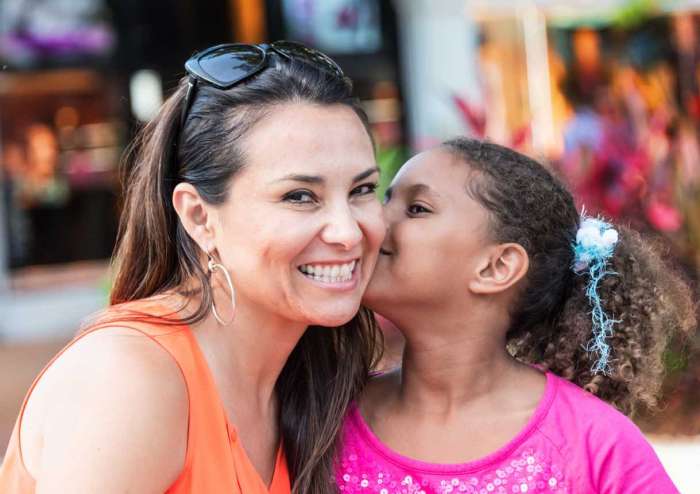If you are a white parent, finding yourself in foreign territory by suddenly needing to take on black hair care without any experience, you might find yourself in a panic. However, don’t. Sure, there is a lot to learn when it comes to taking care of African American hair. But, transracial adoption is growing, and more people are finding themselves in this position. So, help through educational tutorials, hairstylists who demonstrate, and other families sharing the same experience is also growing.
As a white mother or father, you probably didn’t have a lot of experience in working with black children’s hair, and that’s OK. While there is a lot to learn, once you do…and you will, teaching your children how to care for it themselves one day will make it so much easier, as well as help boost their self-esteem.
The first step is to acknowledge that you need help because most of the best tips and techniques that work for your caucasian hair won’t work on black hair. The second important step is to know that even with black hair, no hair is created equal.
Related: The Most Diverse Books for Kids
So, what works for one person, might not for the next. But, this article will share several different black hair care tips and techniques. If one doesn’t work, try another. Or, maybe you will have to combine a few of them for the best solution.
The Structure and Texture of Black Hair

To have a better understanding of how to take care of your child’s hair, it might help to learn a little bit about its structure. This will also help you understand why your hair care might not be the same as it is with black hair care.
Are You Married to Your Work or to Your Spouse?
Some people are fortunate enough to really love their work. They put tons of energy into their job and receive a lot of personal satisfaction from the results. They tend to work long hours and talk enthusiastically about their job to whomever will listen. Most of their friends tend to be from the office. Read More
Each hair strand consists of 3 layers, the cuticle, cortex, and medulla. And, the cuticle is the layer that requires some extra attention in black hair.
The cuticle is a scaly outer layer, designed to protect the inner layers. If the cuticle is lying flat, it helps to retain moisture. On the flip side, if it’s not flat, you will lose moisture, leading to dryness, frizz, and more breakage. And, the curlier the hair, the more the cuticle is raised. If your child is biracial, their hair might be less curly than others. So, adapt the information in this article according to how curly your child’s natural hair truly is.
So, how do you combat the disadvantage of raised cuticles? Start with the washing, or not washing.
A Guide to Black Hair Types
Washing black hair is completely different from washing caucasian hair. But, before you run out to buy a lot of products, you will want to know your child’s hair type. There are 2 basic types, 3 and 4. But, there are subcategories to both types.

Type 3 is often a softer curl, and can be more versatile without chemicals. While a dryer and any other heating device or chemical will dry the hair out more than straighter hair, it can still be used without too much concern. Here are the categories for type 3:
- 3A - Waves or very large curls
- 3B - Spirals and loose curls
- 3C - Springy spiral curls
Type 4 ranges from very curly, to kinky. If your child’s type is one of the 4’s, you might see or hear the word “coily” mentioned. Type 4 consists of the following:
- 4A - Looser coils
- 4B - Tight coils, or a zig-zag pattern
- 4C - No real curl or coil, but more of a kinky pattern
A good way to determine which type you are working with is the shape of the hair when it’s wet. If the curls are an “S” shaped pattern, such as ringlets, then it’s type 3. If you are seeing more of a “Z” pattern, then it’s type 4.
Washing African American Hair
If your hair is straight, you might be accustomed to washing your hair daily, or maybe every other day. Oil and moisture produced from the scalp flow down the hair shaft to provide moisture and protection. But, there can be an abundance of it after a day or two. So, the hair is washed frequently at that point.
That is not how it works for curly hair though. The tighter the curl or coil, the less the oil can travel down the shaft, which leads to dry and brittle hair. So, it is recommended to only wash black hair about once a week, sometimes less.
In addition to frequency, the product is also important. If the hair is not a very tight curl, or too dry, you might be able to get away with using a low alkaline moisturizing shampoo. However, for tightly curled hair, especially type 4 hair, a moisturizing shampoo might not be enough. It might not even be a shampoo at all.
If the hair is a tight curl or coil, and quite dry, you should try a co-wash in place of a shampoo. A co-wash is a product that uses either a mix of conditioner with shampoo or just conditioner. You can either find a conditioner to mix with a low alkaline shampoo, or you can buy a co-wash product specifically for this. The hair won’t lather, so it might not seem like it’s getting clean. But, it is, and it’s far more healthy than stripping the hair of its oils.
Here is a common process for co-washing:
- Wet the hair, and very lightly massage it to remove old oils on the scalp, before adding the co-wash.
- Using a towel, remove excess water. This will help the conditioner to penetrate better.
- Apply the co-wash or conditioner, starting at the roots and working it through to the ends.
- Gently massage the scalp, which will help improve circulation
- Lightly try to work the co-wash or conditioner in the rest of the hair, without tangling.
- Rinse.
If your child has an abundance of hair, you can section the hair and do the above steps in sections.
About once a month or so, a clarifying shampoo should be used to remove buildup. When choosing a product, find one that is best for your child’s hair type, because a product made for type 4C hair would probably be too heavy for type 3A.
Sealing Black Hair
Black hair is often sealed with a leave-in conditioner or oil after washing. This is to help trap moisture in the hair shaft, and can easily be done when the hair is wet. The most popular oils to use are avocado, grapeseed, or jojoba oils. After washing, rinse the hair with slightly cooler water to help close the cuticle, then add the oil. Do not rinse the oil out.
Oil should be added to the scalp and hair in the days between washings as well, even if the hair is not wet.
Combing Your Child's Black Hair

This could be a trial and error moment for you. But, here are some general tips to get you started:
- Do NOT comb the hair while it’s dry.
- Use a wide tooth comb or pick. The tighter the curl, the wider the comb’s teeth should be. You can even find some picks that are infused with oil.
- Comb out the hair with conditioner, either before it’s rinsed out, or using a leave-in conditioner.
- Comb it out in sections, starting at the bottom…and the ends first. Never start at the scalp, or you will end up with a huge tangled mess.
- If the hair starts to dry, add more product and a little water.
You will quickly find out what works for you, and what doesn’t. When it comes to detangling black children’s hair, it often takes product and a lot of patience. Don’t give up, even if it means going through tears and tantrums. If you ignore it and don’t detangle it, it will become nearly impossible to get the mass of tangles out.
Styling Your Child's Hair

If you are an adoptive mom or dad to an African American child, you might feel that you are completely lost when it comes to styling your daughter’s hair. There are many styles to choose from, such as:
- Heat Styling
- Braids and Cornrows
- Dreadlocks
- Natural Curls or Afro
Heat styling requires patience, and can be quite damaging to black hair. Depending on the age of your child, this might be better off later down the road as they age and can handle sitting for long periods. Working with a hot comb or iron with a restless child can lead to injury to the child, you, or both. If you are going to opt for heat styling, ceramic coated tools are best, on a low setting. The hair should be clean, and wait until the hair is completely dry. Purchase a heat protection hair product, and follow directions. However, use these heat tools no more than once a week. Less, if possible.
You are probably more familiar with braids, but they can vary greatly in complexity. You could put in simple and loose braids, or go for tightly-woven braids that can last for weeks, even through washing. Those are often referred to as cornrows. A hairstylist who works with black hair, can do this for your child at first, and show you how to maintain them at home.
Dreadlocks, or locs, involve a technique called locking. This is a twisting or matting of the hair in rows. It resembles a rope. Having this done takes a great deal of time, and has to be cut out. If you want to go this route, it probably should be done by a professional.
Natural hair or an afro is perhaps one of the easiest to achieve if you're working with a type 4. And, it’s becoming more and more accepted, even in the workplace. You will want a decent cut for shape, then it’s mainly about the product. Using the methods for washing, sealing, and combing the hair already mentioned above, the rest is finding the right product to diminish frizz and add shine. You could even add clips, bands, or other decorative items.
None of the above styling types is permanent. So, have fun trying new ways to style the hair to see what is best for your child.
Understanding the Cultural Associations of Black Hair: What NOT to Do or Say

Some of this has been covered already, but a quick summary and quick checklist never hurt. So, here is a Do NOT list for quick reference:
- Do NOT wash African American hair daily, or too often.
- Do NOT use just any shampoo.
- Do NOT go without detangling.
- Do NOT comb natural black hair when it’s dry.
- Do NOT use heat or chemicals on young black children, without extreme care.
- Do NOT think that black children’s hair is extremely limited in hairstyles.
- Do NOT stop learning, researching, and experimenting.
The last “Do NOT” is perhaps the most important, and warrants a bit more discussion…
Do NOT accept African American stereotypes. Black and transracial families have far more flexibility with natural hairstyles than in previous years. It’s becoming far more acceptable to wear their hair natural, in schools and on the job. So, if your child tells you about a discriminatory action or comment regarding their natural hairstyle, it might hurt, or make you angry. But, let them know that things ARE changing, even if it’s slower than what you feel is acceptable.
In the past, it has been considered “unprofessional” for a black woman or man to wear their hair in its natural state when a white woman or man could do so without being called into the office. However, more and more people are standing up for individual rights for a person of color to wear their hair in its natural state, just like caucasian people have been able to do for decades. There is a powerful movement for the ability to wear afros, dreadlocks, braids, and more without reprimand. And, that’s exciting!
Final Thoughts
You will not be learning everything here, but it's good to know what to ask or look for when you start to explore your options.
In addition to research and practice, you can find a licensed professional who is trained in working with black hair, specifically children’s black hair. Book an appointment with them to gather as much information as possible about styling and maintaining your child’s hair.
And most of all, be patient with your child, and yourself. Set aside some dedicated time to wash, comb out, and style your daughter’s hair. A boy’s hair is typically a bit easier, unless they wear it longer. If they do, all the above information is still true.
On a final note, invest in a satin sleep cap, satin or silk pillowcases, or both. A silky cap or silk pillowcase at bedtime will help your child’s hair to slide easier and cause less friction, which will help maintain the style better.



